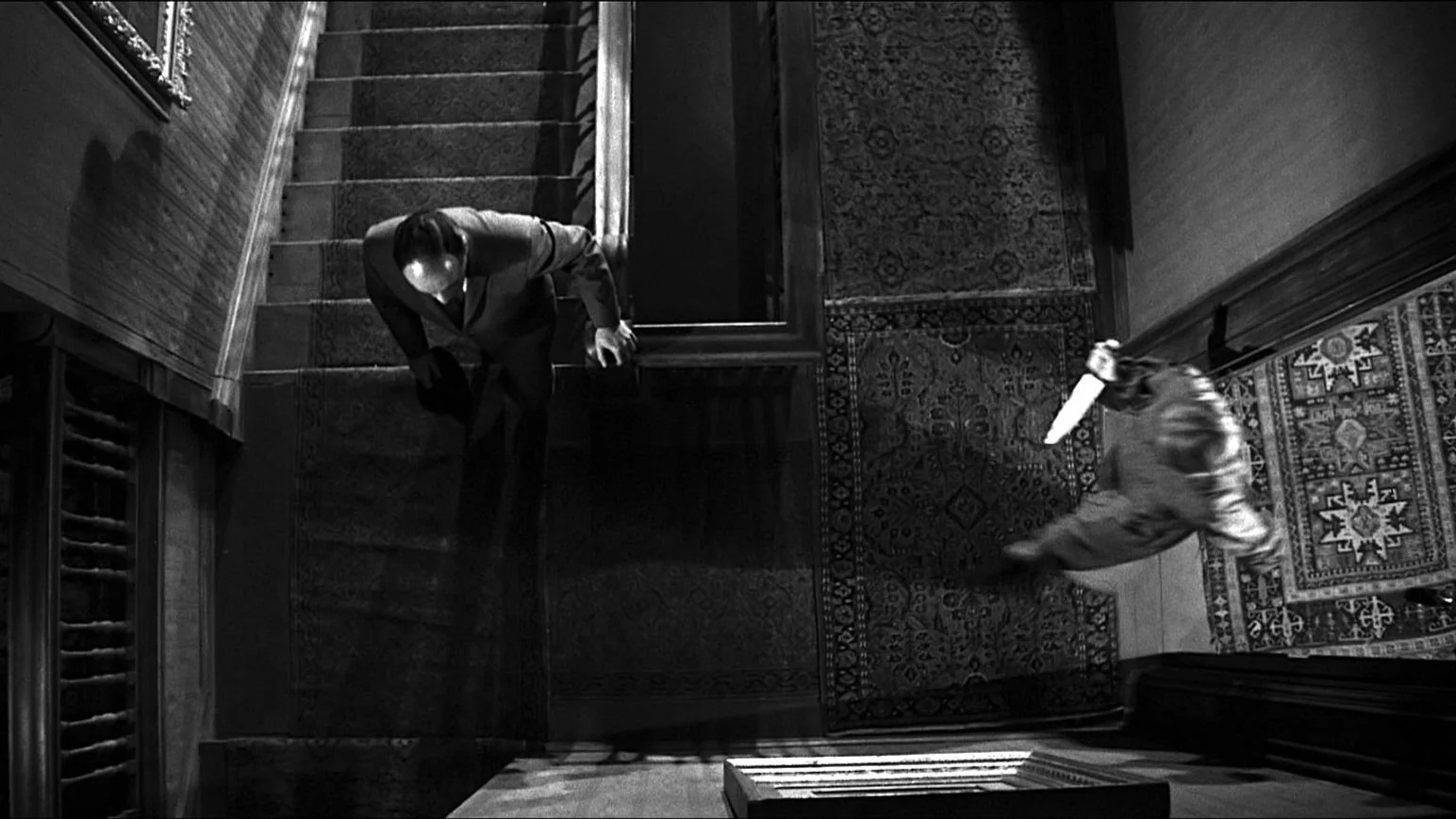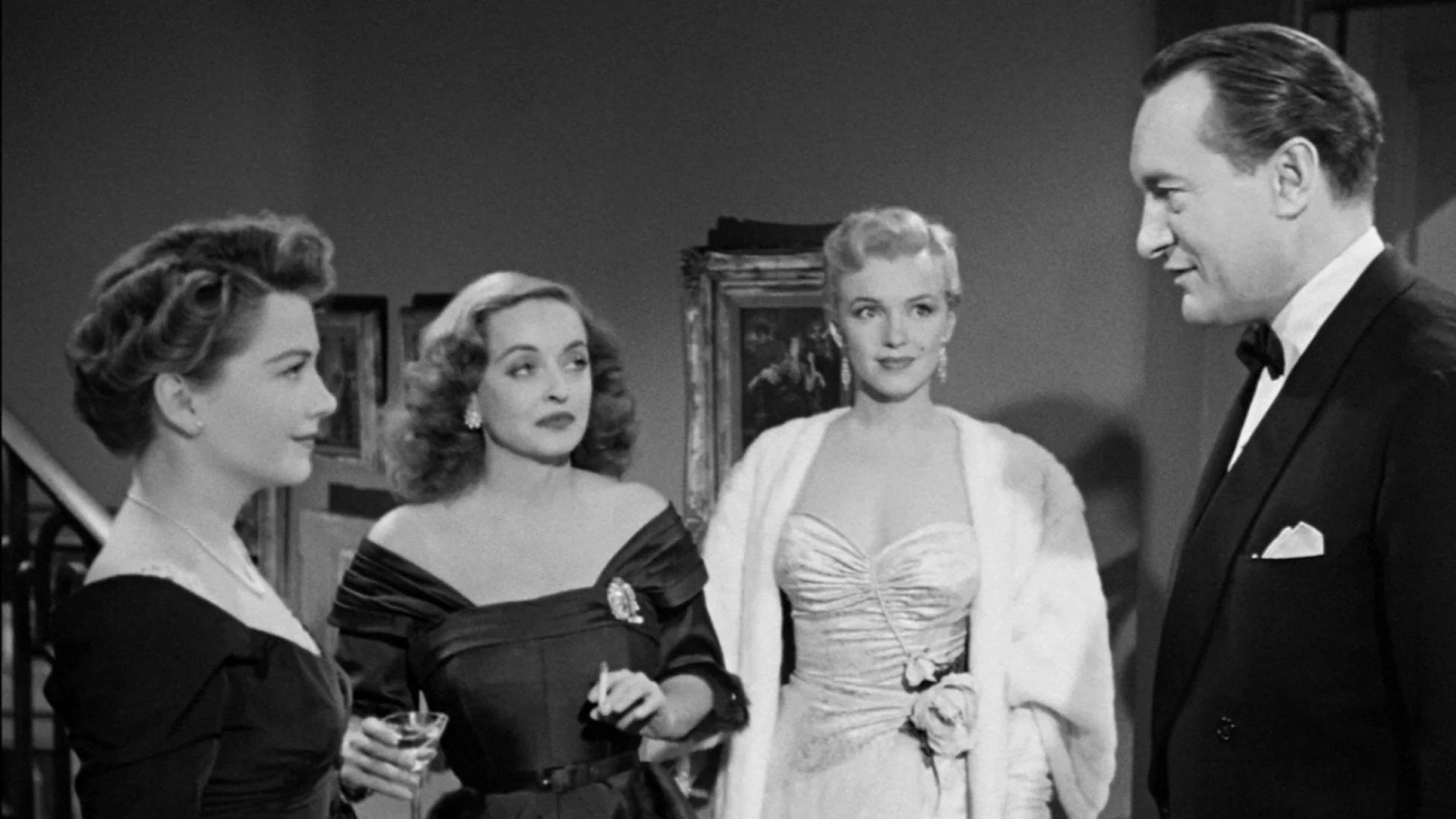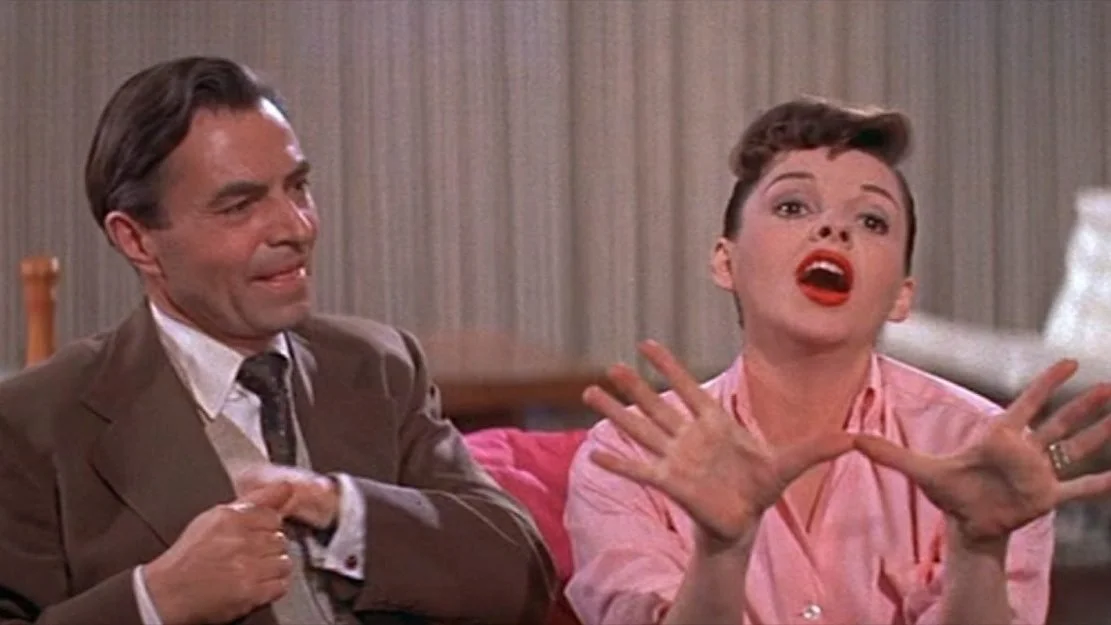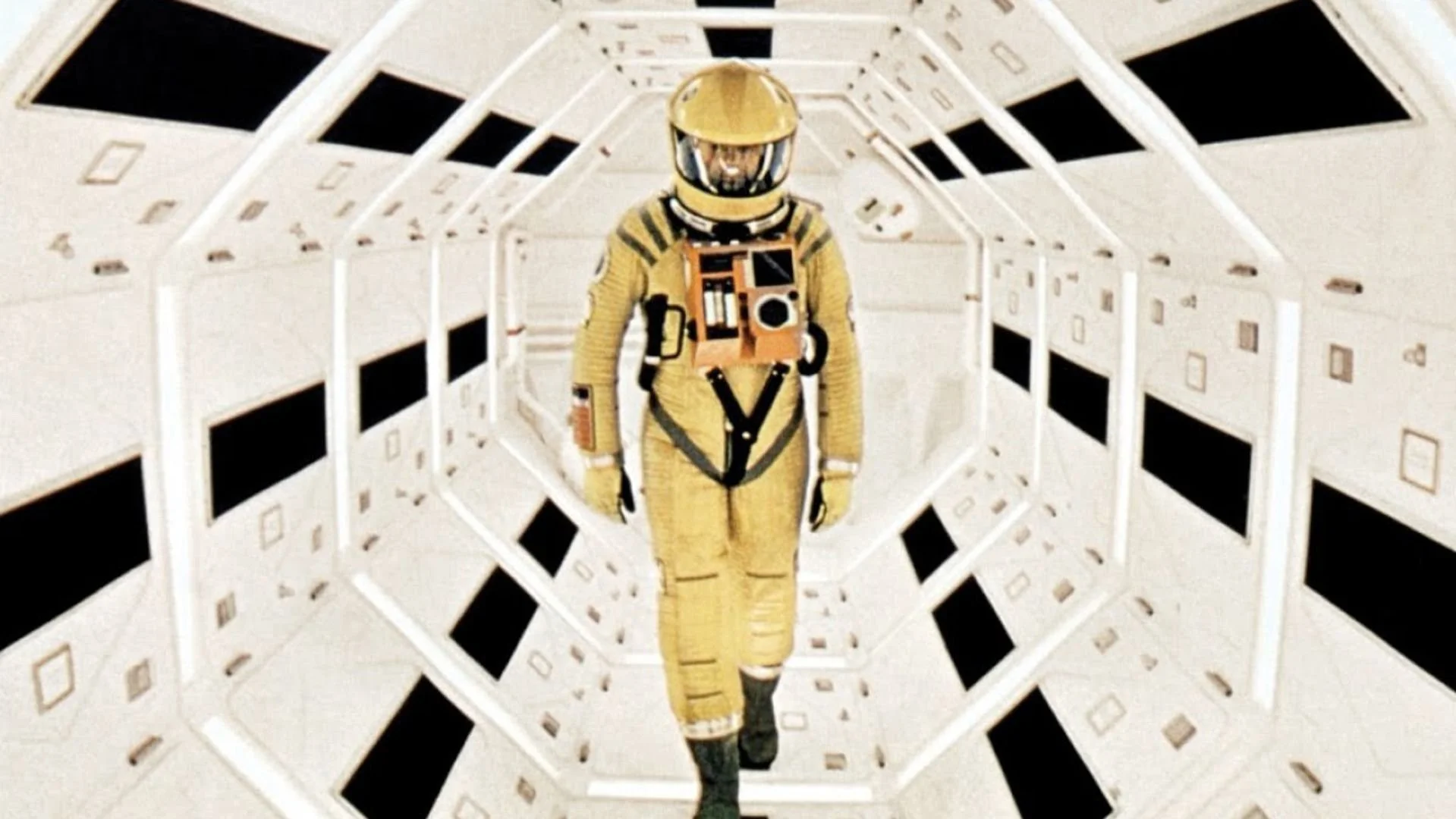70 Years of Film Review: Michael Darvell
Michael Darvell's
Top Ten Films of the Last Seventy Years
Kind Hearts and Coronets (UK, 1949; Robert Hamer)
All About Eve (USA, 1950; Joseph L. Mankiewicz)
Sunset Boulevard (USA, 1950; Billy Wilder)
Singin’ in the Rain (USA, 1952; Gene Kelly and Stanley Donen)
A Star Is Born (USA, 1954; George Cukor)
Le Notti di Cabiria (Italy, 1957; Federico Fellini)
Psycho (USA, 1960; Alfred Hitchcock)
La Baie des Anges (France, 1963; Jacques Demy)
2001: A Space Odyssey (USA/UK; 1968; Stanley Kubrick)
Cinema Paradiso (Italy/France; 1988; Giuseppe Tornatore)
The first thing to admit in making any kind of list is the actual impossibility of choosing just ten films from the past seventy years. As I write this I am aware that if I were asked to do another list in a year’s time, I could very easily choose another ten movies that I would not wish to be without. So, how does one go about choosing a mere ten titles from the past seventy years? Initially I scanned lists of the films released year by year between 1944 and 2014 and marked down what were the best of each year: total: over 400! My next ploy was to select something from each of ten film genres – dramas, comedies, thrillers, musicals, westerns, science fiction, horror, epics, animation and foreign language. That might have cut the total down to around 200… but what could I leave out? In the end I decided to take ten great directors and see if I could come up with a mere ten titles. Here goes…
Alfred Hitchcock has always been a favourite director of mine, both on film and television. He is probably the only film director known to anybody who goes to the pictures, because filmgoers generally only rate actors or the writers of books adapted for the screen. An early encounter with the so-called Master of Suspense came with his silent film of Blackmail (1929), the first British ‘talkie’, which I hired as a teenager to show at home on my Pathescope 9.5 Ace projector. Later on I caught up with most of his output, although until 1960 the only Hitchcock film I saw immediately it was released was Psycho. Between them the National Film Theatre seasons and various London revival cinemas such as the Classic chain furnished me with many other titles I had hitherto missed, such as The Thirty Nine Steps, The Lady Vanishes, Strangers on a Train, The Trouble with Harry, North by Northwest, The Man Who Knew Too Much (1955), Dial M for Murder, Rear Window, Vertigo etc, most of which are among my favourite Hitchcock films.
However, if I had to choose just one from Hitchcock it would be Psycho (1960). At heart Psycho is a black comedy that trades on horror to get its effects. It begins lightly enough as Marion Crane (Janet Leigh) is tempted to run off with the takings from her office safe. In a very Hitchcockian way it conjures up an atmosphere of suspicion and threat (from the police car that follows her) through Marion’s erratic behaviour (she trades her car in for another) and her eventual encounter with Norman, the oddball owner of the Bates motel. In a Hitchcock film, as in life, if you break the law you will be duly punished. Nobody, however, could possibly foretell the treatment meted out to Marion and to those who come looking for her. The horror is unexpected and, even after many viewings, Psycho never fails to shock. It is pure cinema and sees Hitchcock at his black comic best.
Unbeknownst to Martin Balsam... just one of the many iconic scenes from Alfred Hitchcock's Psycho
Staying with the theme of black comedy, it is director Robert Hamer who made my favourite Ealing Studios film, Kind Hearts and Coronets (1949). A fine writer and director, Hamer worked with Hitchcock on Jamaica Inn but really came into his own with such films as Dead of Night, Pink String and Sealing Wax, It Always Rains on Sunday, Father Brown and School for Scoundrels, his last film before he died prematurely at age 52. Kind Hearts and Coronets is not only his best film but also that of Dennis Price playing Louis D’Ascoyne who plans to murder all the members of his family who stand in the way of his line of succession. It also has marvellously unorthodox performances by Valerie Hobson and Joan Greenwood as well as Alec Guinness’s tour-de-force in playing all eight of the D’Ascoyne family members that Louis needs to remove.
Valerie Hobson and Dennis Price in Kind Hearts and Coronets
Like Robert Hamer, Joseph L. Mankiewicz was a brilliant screenwriter and director. He began in silent pictures writing intertitles and for most of his career he wrote his own screenplays and, although he was sometimes not credited, his writings were always literate. His films included Dragonwyck, The Ghost and Mrs Muir, A Letter to Three Wives, Five Fingers, Julius Caesar, The Barefoot Contessa, Guys and Dolls, Suddenly, Last Summer and Cleopatra. My favourite will always be All About Eve (1950), a story of the Broadway theatre for which Mankiewicz managed to tame Bette Davis into giving her best performance ever on screen. In a wonderfully biting satire on the mores of the stage and its spoilt, childish inhabitants in which he cast everybody to perfection: Anne Baxter as the evil Eve Harrington, who tries to oust stage star Margo Channing (Davis) from her lofty pedestal, Celeste Holm as Margo’s best friend, George Sanders as an acid theatre columnist, Gary Merrill as Margo’s director husband, Thelma Ritter as Birdie, Margo’s personal dresser, and even Marilyn Monroe as an ingénue player on the make. It’s one of the wittiest screenplays ever filmed and always repays repeated viewings.
Anne Baxter, Bette Davis, Marilyn Monroe and George Sanders in All About Eve
Like Hitchcock Billy Wilder also made many outstanding films, so how could I possibly choose one from Double Indemnity, The Lost Weekend, Ace in the Hole, Stalag 17, Witness for the Prosecution, Some Like It Hot, The Apartment, One, Two, Three, The Fortune Cookie, The Front Page etc – all fine contenders but… in the end I think it has to be Sunset Boulevard (1950). Wilder too had a penchant for black comedy which is amply demonstrated in this film. It pays tribute to the silent cinema and yet its main protagonist, the former silent movie star Norma Desmond, played by Gloria Swanson, is still living in the past, more or less a prisoner in her own mansion with just her memories, a pet monkey and former husband Max, who is now her butler keeping her legend alive by writing bogus fan letters. The woman is obviously mad but her life seems to pick up when film writer Joe Gillis (William Holden) turns up and offers to re-write her screenplay of Salome. She thinks she is due a comeback but, like the cinema itself, this is a total illusion.
Norma's close-up
Staying with the movie business as a theme, my next two films also show life upon the silver screen. Director George Cukor I admire for filming fine versions of stage plays from A Bill of Divorcement in 1932 to Dinner at Eight, Romeo and Juliet, Holiday, The Philadelphia Story, Gaslight, Born Yesterday and My Fair Lady, among others. Also known as a sympathetic director of actresses (The Women being a prime example) he produced a stunning performance from Judy Garland in A Star Is Born (1954). A story filmed many times in different ways, first by Cukor in 1930 when it was known as What Price Hollywood? and then in 1937 with Janet Gaynor and later with Barbra Streisand in 1977, the Cukor-Garland version is the best, even though it was originally heavily cut by the distributors. Most (but not all) of the missing footage has been restored and it makes very credible the old story of one star on the road to success while another is on the wane. Garland is superb as the rising actress Vicki Lester, torn between her increasing success and her wayward husband, Norman Maine (the excellent James Mason), who is on the downward slide through his alcoholism. The songs are integrated into the piece so that it’s a Hollywood drama with songs rather than an out and out musical. It never ceases to surprise or please.
Stellar birth: James Mason with Judy Garland in George Cukor's A Star is Born
Another musical I would hate to be without is Singin’ in the Rain (1952), the work of Gene Kelly and Stanley Donen who between them directed many favourite film musicals, including On the Town, Seven Brides for Seven Brothers, It’s Always Fair Weather, Funny Face, What Lola Wants and Hello, Dolly! They both directed and choreographed Singin’ in the Rain and it has some classic moments such as the Broadway Melody sequence and a terrific and very funny screenplay by Betty Comden and Adolph Green that sends up the transition in Hollywood from silent films to talking pictures. Kelly stars with great support from Debbie Reynolds, Donald O’Connor and Jean Hagen. Singin’ in the Rain is a true classic and, although ostensibly a musical comedy, is arguably the best film about the movies.
The shower scene: Gene Kelly, Debbie Reynolds and Donald O'Connor in Singin' in the Rain
Choosing a mere ten films for me means omitting the work of many great directors, such as Preston Sturges, Woody Allen, David Lean, Fred Zinnemann, John Ford, Orson Welles and Otto Preminger, all of whom have made classic movies as well as more run of the mill material. It also means leaving out luminous star actors such as Cary Grant, Greta Garbo, Katharine Hepburn, Spencer Tracy, Joan Crawford and Fred Astaire, to name but a few. They will all be in my Top 100 films of all time. One film that I would include has no real stars but it is directed by one of the supreme artists of the cinema, Stanley Kubrick. I have admired his work from his earliest, independent films (Killer’s Kiss, The Killing, Paths of Glory) through his epic, event movies such as Spartacus, Dr Strangelove, A Clockwork Orange, Barry Lyndon, The Shining and Full Metal Jacket. His magnum opus, however, is 2001: A Space Odyssey (1968), undoubtedly the best and certainly the most original space fiction film ever made. Long before CGI had been thought-of, let alone invented, Kubrick’s special effects were all composed in the camera and on the huge Cinerama screen you could never see – and still cannot see – the joins. It is a great film because it stays on a human level and never lets the effects take over. After repeated viewings it is still an enigma, a work of art that goes on giving and keeps you thinking about the place of man in the cosmos.
Future tense: Stanley Kubrick's 2001: A Space Odyssey
And so we come to what Film Review has always called the Foreign Film. From a choice that includes the work of Bergman, Truffaut, Godard, De Sica, Clair, Renoir, Rossellini, Kurosawa, Buñuel, Eisenstein, Antonioni, Ozu, Ray, Bertolucci, Mizoguchi, Bresson, Visconti, Dreyer, Carné, Cocteau and Resnais et al, I have settled for three directors whose work I never stop admiring. French cinema has always had a place in the forefront of movie history; after all it produced pioneers such as Georges Meliès and the Lumière brothers. A pioneer in his own way was the writer and director Jacques Demy. He came to international notice in 1964 with his ground-breaking, through-sung The Umbrellas of Cherbourg, which had no spoken but only sung dialogue. I would if I could take that film, along with Demy’s tribute to the Hollywood musical, Les Demoiselles de Rochefort, an all-time favourite of mine. However, I have chosen instead La Baie des Anges (1963), made a year before Umbrellas. It is more than just a love story in which Jean (Claude Mann), a bank clerk, meets Jackie (Jeanne Moreau) at a casino because, whereas Jean is much taken by Jackie, she is more beguiled by the roulette wheel and only interested in Jean while she is winning. It’s a superb depiction of gambling fever, possibly the best yet on film, and this feeling is due in no small part to the contribution by Demy’s favourite composer Michel Legrand whose music underscores the passion of both gambling and romantic love.
Music has always played a vital part in the films of Federico Fellini. He often used Nino Rota to compose for his films and Le Notti di Cabiria (1957) is no exception. This was one of the first Italian films I ever saw and it greatly impressed me. I was immediately taken up with Fellini’s portrayal of an ordinary prostitute in Rome who cannot find real love but who instead encounters a famous film star and enjoys a brief taste of luxury before returning to the street. However, nothing lasts for Cabiria because eventually all her men do her down either by robbing her and throwing her in the river or just deserting her. Fellini’s wife, Giulietta Masina, is perfect as Cabiria (Best Actress at Cannes) and the film, enhanced to a great degree by Nino Rota’s terrific music, won the Academy Award for Best Foreign Film in 1958. Later on the story formed the basis of the musical Sweet Charity, but the original screenplay is still the better bet.
Federico Fellini's Le Notti di Cabiria
Finally another Italian film that uses music as an integral part of its make-up, Giuseppe Tornatore’s Cinema Paradiso (1988) which also sums up one’s own personal love for the movies. It tells of a young boy, Toto, and his fascination with his village cinema in Sicily and the friendship that grows between him and Alfredo, the old projectionist. The boy grows up and leaves Sicily for Rome and only returns some thirty years later when he learns that Alfredo has died. The funeral is one of the most moving scenes in all cinema in which Tornatore’s camera and Ennio Morricone’s music combine to make it a truly emotional finale. It has fine performances by nine-year-old Salvatore Cascio as Toto, Jacques Perrin as the adult Toto, and in particular the heartbreaking Philippe Noiret as Alfredo. This classic film includes some fifty clips from old films that make it almost a history of world cinema in itself, an ideal companion to illustrate seventy years of cinema, particularly if you are marooned on desert island.
MICHAEL DARVELL
The young Salvatore Cascio is entranced by the silver screen just as Michael Darvell was (and still is) - in Giuseppe Tornatore's Cinema Paradiso









